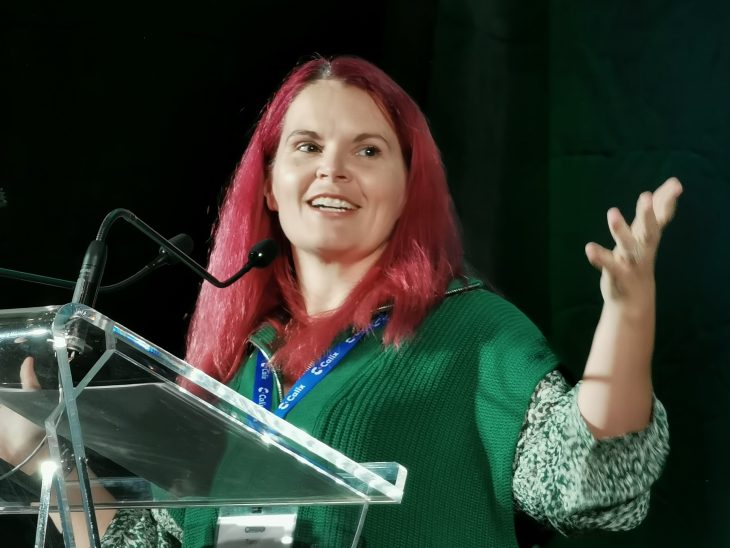
By Lynn Greiner
GEORGINA, Ont. – Last week’s Canadian Rural and Remote Broadband Community Central Canada conference kicked off with a pair of keynotes: one on an international perspective of rural broadband, and one looking at Canada’s landscape.
Michael Weening (pictured below), president and chief operating officer at Calix, a supplier of cloud and software platforms and services for communications service providers, first talked about why the best providers for rural and remote areas are not the big guys, but those rooted in the community.
“Broadband is all about community,” he said. “I was at a conference about a month ago, and I was there with about 80 or 100 CEOs. And on this panel, I was asked a question: what will close the digital divide? There was someone from a very large company who was also on the panel, and he talked about how he had partnered with the state and they were rolling out fibre to these different folks. And he said, ‘we’re going to help close the digital divide’. And then it swung to me, and I said, ‘No, he’s not, because he doesn’t care about his local community. A big company, who is actually just rolling out broadband as a profit center does not care about the local community.’ And that is the truth of rural Canada. That’s the truth of rural United States.”

Small companies, municipalities, family-owned businesses and cooperatives are actually going to close the digital divide, Weening said, because they care about the community they live and work in. They know that broadband, and the associated services, will completely change the lives of people.
“When I was on stage last year, we had a rural broadband electric cooperative in rural Tennessee, and one of the areas that they’re building into is the 13th poorest region in North America, dirt poor,” Weening explained, as an example. “And what they decided to do was actually build out their entire business into that market. Why? In his words, because it’ll have a multi-generational impact on those families. It will raise children out of poverty, it will help them get education, it will actually completely transform the 13th poorest place.”
The cooperative model succeeded in the U.S., he pointed out, first with electric coops that ran power to farms and other places where the big companies didn’t want to go, then later with telecom coops that did the same. Unlike politicians, whose priorities change from depending on who’s elected, the coops kept their focus. “As you know, infrastructure can’t be transitory,” he said.
He believes that fibre should go everywhere; the only place he sees for satellite communications are what he called “super rural areas”.
“You have to break out of the network, you have to break out of speed and have to start thinking experience,” he concluded. “And it’s experiences that are going to transform towns. They’ll say this is a revolution. This is where small municipalities, cooperatives, small businesses that are owned by families, public-private partnerships actually rise up against big companies through the power and democratizing power of the cloud software platforms and completely change the game. The future is you. The future is rural.”
Tanya O’Callaghan (above), vice president of community investment, policy and advocacy at the Canadian Internet Registration Authority (CIRA), picked up the theme, discussing lessons learned during the pandemic. First, she said, the pandemic cemented the critical role that the Internet plays in everyone’s life.
“Without high-speed broadband, you cannot participate fully in society,” she pointed out. “And you can’t take advantage of all the cultural and the economic and the social opportunities and choices that life has to offer. The pandemic certainly cemented that.”
O’Callaghan cited a Canadian study that found that broadband deployment has created growth in aggregate employment, and in wages, especially in rural regions. In services industries, it said, employment growth increased by 1.17% per year when broadband arrived, and wages increased 1.01 percentage points each year.
Bridging the digital divide requires money, but beyond that, she said, “what’s needed is actual collaboration and active engagement from those government stakeholders to work with and listen to your communities and the needs from the people on the ground.”
Secondly, they need data, O’Callaghan said, explaining “it is critical to measure Internet performance with a tool like CIRA Internet Performance Test. We need to measure before we make any investments to help plan and understand the benchmark. And we need to measure on an ongoing basis to ensure that programs deliver when they say they will. This is absolutely a case where the old adage is true: you can’t improve what you don’t measure.”
She said stakeholders such as funders, governments, and ISPs need to get together and have a collaborative dialogue to get things moving and discussed the role of historical records from the Internet Performance Test in gauging progress.
But will we ever close the digital divide?
“I don’t think we ever actually fully will,” O’Callaghan said. “I think at the end of the day, we’ve made significant progress and we will continue to do so. But I think there’s geographic and economic and technical barriers that will probably always remain and mean we might never have full parity between rural and urban areas.
“One of the biggest challenges is that even with investments from government, the economies of this problem don’t change. And hopefully, we’re not here 20 years from now, still having these conversations.”
Photo of Michael Weening borrowed from Calix’s website, photo of Tanya O’Callaghan taken by Lynn Greiner at the CRRBC Central Canada 2022 conference.



